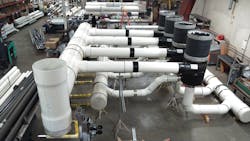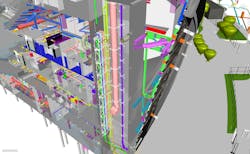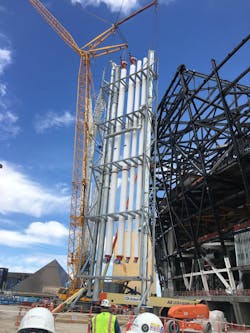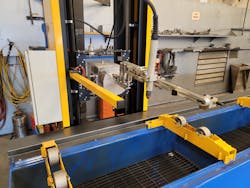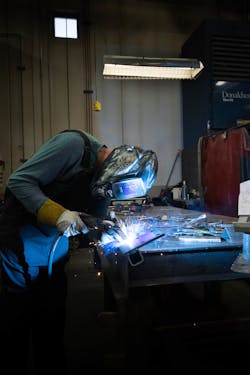BELLINGHAM, WA and ZUMBROTA, MN — Leading national mechanical contractor Harris is answering critical trends in the construction industry to deliver shorter project schedules and answer workforce shortages by opening its new state-of-the-art prefabrication shop in Bellingham, Wash.
The 41,000-sq.-ft. Pacific Northwest shop houses its sheet metal, plumbing and pipe fabrication shops, and supports projects by crafting HVAC ducts, HVAC piping, plumbing piping and purity gas piping.
Harris’ Bellingham shop can adapt to challenges and handle unexpected items on a quick turnaround, often in less than 24 hours. This local facility’s average fabrication is 64 pounds per hour. With this premier fabrication shop, Harris has the expertise and resources to develop advanced solutions and deliver results.
And it’s not a stretch to say that the new Bellingham prefab shop mimics some of Harris’ other shops nationwide. Harris has nine state-of-the-art fabrication shops across the country—totaling just over 270,000 sq. ft. of manufacturing space. The company has been very strategic and thoughtful in its response to meeting the increasing industry demand for prefabricated mechanicals in building construction. Maintaining regional, strategically located in-house fabrication facilities is a big part of that.
A Better Way
And here’s why. “While prefabrication and modularization have been used extensively in manufacturing, widespread use in the construction industry is more recent,” says Mike Nelsen, Plant Manager, Midwest Fabrication & Supply (MFS), Harris, Zumbrota Minn. “As the trade labor shortage became more prominent over the last five to 10 years, the industry shifted and innovative companies started looking at better ways for project teams to come together and maximize opportunities for prefabrication. Harris has taken full advantage of the progression we’ve seen in BIM, virtual design and construction (VDC) and prefab equipment,” says Nelsen.
Across the country, Harris has more than 110 BIM professionals, 129 piping workers and 160 sheet metal workers. “At Harris, prefab and BIM/VDC work hand in hand,” says Nelsen.
“We use BIM and VDC to provide greater accuracy in budget, cost estimation, scheduling, multi-trade and discipline coordination, fabrication, safety and constructability. All of our prefab shops work closely with our in-house design studio to maximize prefabrication and deliver significant value throughout the life cycle of the project,” continues Nelsen.
Just to reiterate, Harris’ prefab approach focuses on innovation, efficiency and safety. Harris also takes a “prefab everything” approach—whether it’s as simple as adding an elbow off a piece of copper pipe or manufacturing massive multi-trade racks for just-in-time delivery to a project site.
“With today’s advanced modeling tools, it’s much easier to identify ways to maximize prefabrication and modularization. There’s no reason that a building can’t be designed with prefabrication in mind.
“With building information modeling (BIM), the benefits of using prefabricated components can be seen at a granular level, meaning the building itself can be seen virtually and visualized much earlier in the process. Our prefab approach is collaborative across all Harris locations, areas of expertise and trades to ensure we deliver innovative and cost-effective solutions to customers,” says Nelsen.
Hub-and-Spoke Approach
According to Nelsen, the many different projects Harris has taking place are referred to as the spokes around that hub. The customized portion of the fabrication is done at the hub. “We then flat-pack those products in a way that’s efficient to ship and then ship those flat packs to a job-specific location where assembly takes place or to a co-fabrication site on-or-near the project,” says Nelsen.
With this method, the collaboration between MEP trades and the overall workflow is heightened and schedules are optimized as multiple building systems integrate. “Overall, with the hub-and-spoke method, you don’t ship as much air, which is typically the case when dealing with large duct systems and pipe. The process allows for just-in-time delivery, convenient storage of materials, collaboration with other trades, and compilation/staging of oversized assemblies,” says Nelsen.
“What that means for our customers is that we can yield product and materials with unmatched precision at a high speed. Our team manufactures every component to exact specifications using industry-leading equipment. Whether a project calls for HVAC ductwork, high-pressure air and nitrogen lines or process piping, we’re able to produce high-quality results,” says Nelsen.
In the end, prefabrication addresses critical trends in the construction industry, which includes delivering shorter project schedules and workforce shortages. More specifically, prefab addresses building trends also include panelization, modular construction, volumetric construction, container construction and digital modeling.
Harris-wide Prefab Facts
• 126,100 sheet metal shop square feet
• 144,600 piping shop square feet
• 11.7M sheet metal pounds produced
• 80 pipe stations
• 129 piping workers
• 160 sheet metal workers
Sampling of advanced technology
4K Fiber Laser
• Fully automated machine with load/unload capabilities
• Can cut HVAC products up to 2,000 inches per minute
• Produces high-quality cuts with little to no burr
• Cleaner cuts and less prep time for welded projects due to use of nitrogen assist gas
• Can cut 9 inches in diameter
• Fully automated back gauge processes lengths of 20 feet of pipe
• Capable of pushing material up to 200 pounds
• Full nesting capabilities, has user-defined cut lists
• Fully automated 6 Axis profiler, computer controlled
• Capable of processing pipe 2” to 24” in diameter and up to 24’ in length
• 3D-Profile Plus software allows for seamless integration from the model
• Hypertherm 125 plasma cutting system further expands capabilities, increases cut speed, drives down operating costs and ensures unmatched cut quality on mild steel, stainless steel and aluminum
Safety First
Harris’ team of expert fabricators is certified in pressure vessel repairs and alterations, power piping, power boilers and a wide range of welding specialties. To move a project forward, Harris has allowed other trades to work at its manufacturing facilities on the components it has assembled. Whatever the job involves—welding, grinding, grooving, assembly—safety is the first priority.
Certifications Include:
• ASME: R (Pressure Vessel Repairs and Alterations), PP (Power Piping), S (Power Boilers)
• Flux Core Arc Welding (FCAW)
• Gas Metal Arc Welding (GMAW)
• Gas Tungsten Arc Welding (GTAW)
• Shielded Metal Ar
Advantages of Prefabrication
• High-quality components in a safe controlled environment
• Compressed schedule
• Reduction of workers needed on site
• Increased energy efficiency
• More efficient logistics
• Reduction of waste
• Flexibility
• Weather conditions become less of a factor
